Cone Health used patient analytics to decide how many physicians, cardiologists and nurse practitioners to hire as it expanded diagnostic capacity in Greensboro, Nanda says.
Big Data and health analytics systems have matured and can now identify gaps in a care team’s workflow, particularly for specific age groups, according to Nanda.
“If we can deliver care gap closures that are recommended for specific age groups and education materials to keep our patients healthy, it will go a long way to support preventive care,” he says.
In addition to preventing a disease from occurring, preventive care also includes secondary prevention, in which healthcare providers aim to prevent a condition from worsening, Nanda explains.
Here are five areas in which Big Data can optimize preventive care:
1. AI in Predictive Analytics and Reporting for Healthcare
AI allows preventive care physicians to predict the behavior of patient populations, which allows care providers to act before an illness occurs.
Integrating AI into analytics and reporting allows health systems to combine retrospective analytics with real-time reporting. UnityPoint has found success using ML as a forward-looking decision support aid, Harms says.
Meanwhile, natural language processing can pull information from dictated documents to determine which patients in recommended age groups require automated reminders to get mammograms, Nanda explains.
“Otherwise, someone from the provider office would be scouring through charts to figure out who’s due for what, or they would be filing their charts or tagging their charts in such a way that they can identify who’s due for a service,” he says.
AI can also help care teams query a database to see for which conditions a patient is at risk based on ethnicity, gender or family history, according to Nanda.
Click the banner below to learn how a modern data analytics program can optimize care.














